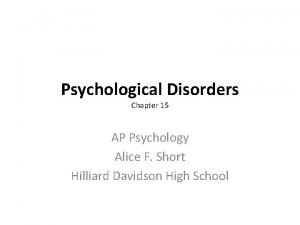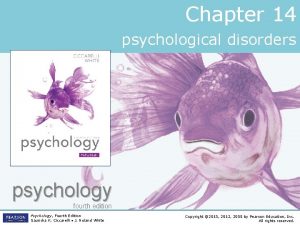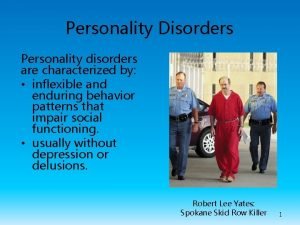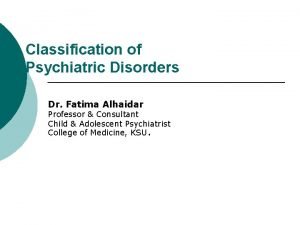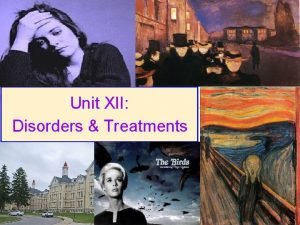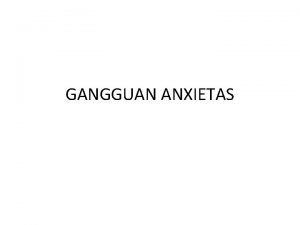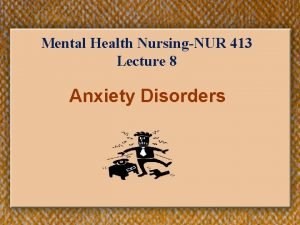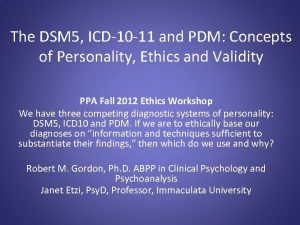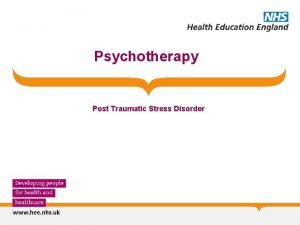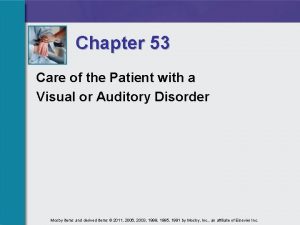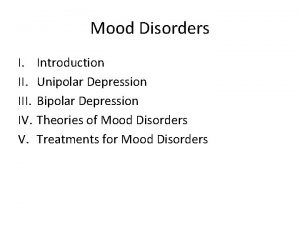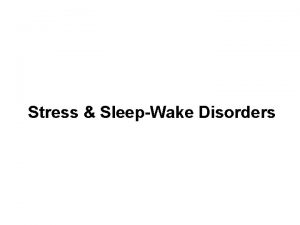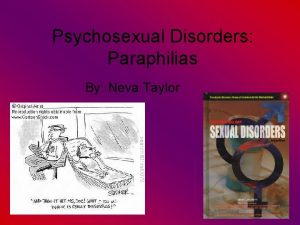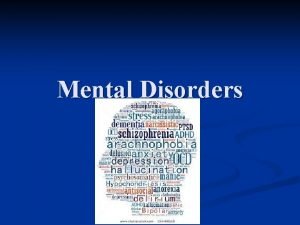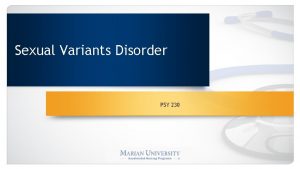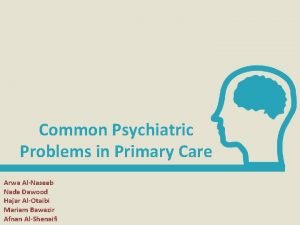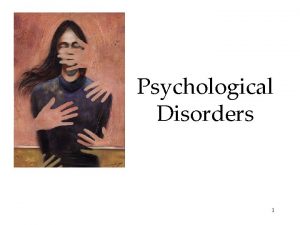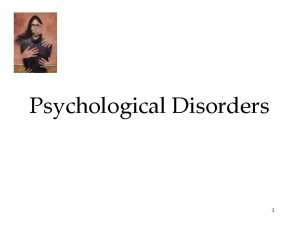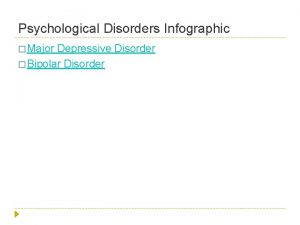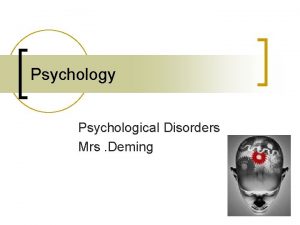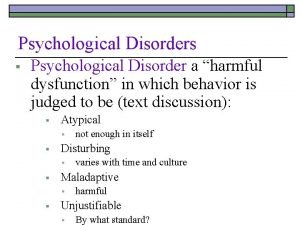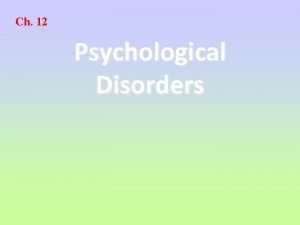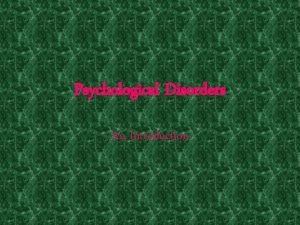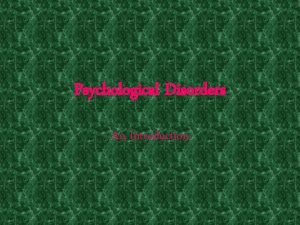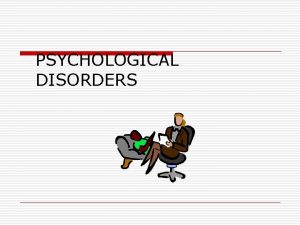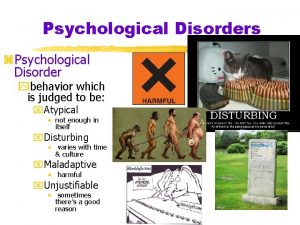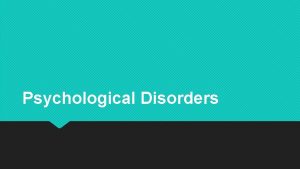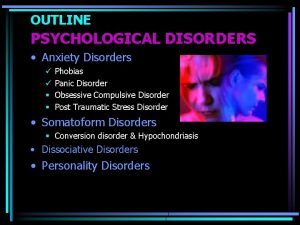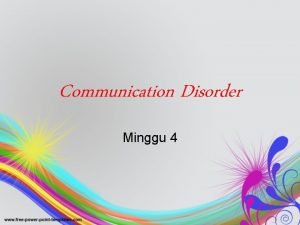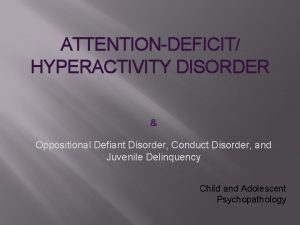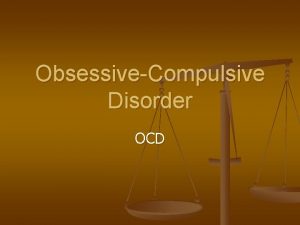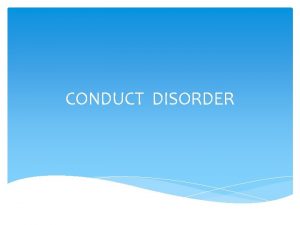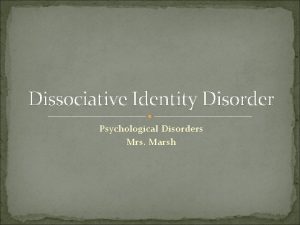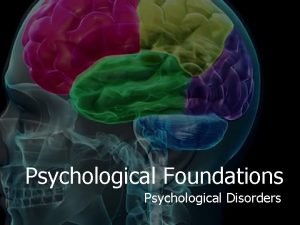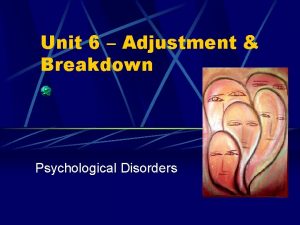Psychological Disorders Mrs Sandersl Psychological Disorders Psychological Disorder


























- Slides: 26

Psychological Disorders Mrs. Sandersl

Psychological Disorders § Psychological Disorder § a “harmful dysfunction” in which behavior is judged to be: § § atypical--not enough in itself disturbing--varies with time and culture maladaptive--harmful unjustifiable--sometimes there’s a good reason

Historical Perspective § Perceived Causes § movements of sun or moon § lunacy--full moon § evil spirits § Ancient Treatments § exorcism, caged like animals, beaten, burned, castrated, mutilated, blood replaced with animal’s blood

Perspectives and Disorders Psychological School/Perspective Psychoanalytic/Psychodynamic Cause of the Disorder Internal, unconscious drives Humanistic Failure to strive to one’s potential or being out of touch with one’s feelings. Behavioral Reinforcement history, the environment. Cognitive Irrational, dysfunctional thoughts or ways of thinking. Sociocultural Biomedical/Neuroscience Dysfunctional Society Organic problems, biochemical imbalances, genetic predispositions.

Psychological Disorders § Medical Model § concept that diseases have physical causes § can be diagnosed, treated, and in most cases, cured § assumes that these “mental” illnesses can be diagnosed on the basis of their symptoms and cured through therapy, which may include treatment in a psychiatric hospital

Psychological Disorders § Bio-Psycho-Social Perspective § assumes that biological, sociocultural, and psychological factors combine and interact to produce psychological disorders

Classifying Mental Illness �DSM-IV �Diagnostic and Statistical Manual of Mental Disorders �Sets forth specific diagnostic criteria for disorders and helps differentiate between disorders �Labels a person – can have negative influence on person’s future � Impacts how others regard/view person


Insanity �Legal term �Many people with Psych disorders are SANE �Unaware of actions at the time of the crime �“Not guilty by reason of insanity” – studies show, held as long in mental institution as if found guilty

Mood Disorders �Major depressive Disorder �At least 2 weeks feeling depressed, sad, etc �Reduced ability to function with others �Bereavement does not currently count �Problems with eating, sleeping, thinking, concentrating, decision making. Lack of energy. Suicidal thoughts, feeling worthless or guilty

Mood Disorders �Bipolar Disorder �Manic phase – elation, distractibility, racing thoughts, exaggerated self-esteem �Depressive phase �Varying forms �Seasonal Affective Disorder �EX. Depression during winter

Suicide �More than 30, 000 Americans per year �Women attempt suicide more �Men successfully complete suicide more �Most people that threaten suicide ARE serious �Upwards of 70% of people who commit suicide threatened to do so within three months preceding the suicide

Anxiety Disorders �Anxiety – general state of dread or uneasiness in response to imagined danger �Most common type of mental illness in US �Affects 40 million Americans annually �Generalized Anxiety Disorder – continuous or generalized anxiety �Phobic Disorder �Specific phobia – almost anything �Social phobia – speaking in public �Agoraphobia – fear of public place

Anxiety Disorders �Panic Disorder �OCD �Compulsions – repeating behaviors �Obsessions – uncontrollable thoughts �PTSD �Post-Traumatic Stress Disorder �Can be caused by any traumatic event (not just war)

Somatoform Disorders �Physical symptoms with no physical cause apparent �Conversion disorder �Converting emotional difficulties into loss of specific physiological function �Hypochondriasis �Person in good health becomes preoccupied with imaginary ailments

Dissociative Disorders �Alterations in memory, identity, or consciousness �Dissociative amnesia �Inability to recall personal events (rest of memory intact) �Dissociative fugue �Travels away from home or work & unable to recall past �DID – Dissociative Identity Disorder �Formerly Multiple Personality Disorder �Two or more distinct personalities �Rare and controversial

Schizophrenia �Group of disorders �Confused and disconnected thoughts, emotions, perceptions � 1% of people worldwide �Delusions (false beliefs) can occur as well as hallucinations (perceptions with no external cue) �Sped up speaking “word salad” �Types: paranoid, catatonic, disorganized �Much debate over cause

Personality Disorders �Maladaptive or inflexible ways of dealing with others and one’s environment �Antisocial Personality Disorder �Disregard for and violating rights of others without remorse �Often intelligent, entertaining, and or able to fake emotions �Borderline Personality Disorder �Unstable emotions, fear of abandonment, inappropriate anger, feelings of worthlessness, impulsive, self-injury

Histrionic Personality Disorder �Needs to be the center of attention. �Whether acting silly or dressing provocatively.

Narcissistic Personality Disorder �Having an unwarranted sense of selfimportance. �Thinking that you are the center of the universe.

Other Disorders • Paraphilias (pedophilia, zoophilia, hybristophilia) • Fetishism • sadist, masochist • Eating Disorders • Substance use disorders • ADHD

Rates of Psychological Disorders

Psychotherapy �Treatment used by therapists to help trouble people overcome their problems � Verbal interaction between therapist and client � Development of a supportive and trusting relationship � Analysis by therapist of the client’s problems �Help people understand take ownership in solving problems �Can take on many forms


Group Therapy �Patients work together with the aid of a leader �Helps patients see how other people are struggling with similar problems �One therapist can help a large number at a reduced cost Cognitive-Behavioral Therapy �Substituting healthy thoughts for negative ones �Changing disruptive behaviors for healthy ones

 Somatization disorder dsm 5
Somatization disorder dsm 5 They are mrs garcia and mrs castro
They are mrs garcia and mrs castro They are mrs garcia and mrs castro
They are mrs garcia and mrs castro Mrs. darling was ___________ of mrs. s.
Mrs. darling was ___________ of mrs. s. A beautiful mind psychological disorder
A beautiful mind psychological disorder Chapter 18 psychological disorders
Chapter 18 psychological disorders Ap psychology chapter 15 psychological disorders
Ap psychology chapter 15 psychological disorders Chapter 18 psychological disorders
Chapter 18 psychological disorders Chapter 14 psychological disorders
Chapter 14 psychological disorders Group c personality disorders
Group c personality disorders Chapter 14 psychological disorders
Chapter 14 psychological disorders Psychological disorders
Psychological disorders Bipolar disorder meaning
Bipolar disorder meaning If barbie were real
If barbie were real Obsessive compulsive disorder
Obsessive compulsive disorder Examples of generalized anxiety disorder
Examples of generalized anxiety disorder Dsm 5 axis chart
Dsm 5 axis chart Cptsd
Cptsd Chapter 53 care of the patient with a sensory disorder
Chapter 53 care of the patient with a sensory disorder Unipolar disorder
Unipolar disorder Adjustment disorder
Adjustment disorder Neva taylor
Neva taylor Ritailin
Ritailin Chapter 7 vocabulary practice extending mendelian genetics
Chapter 7 vocabulary practice extending mendelian genetics Orgasmic dysfunction
Orgasmic dysfunction Generalized anxiety disorder dsm 5
Generalized anxiety disorder dsm 5 Dissociative state
Dissociative state






